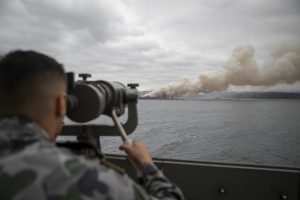Australia is now entering the fifth month of devastating wildfires raging across four of its six states. The fires, fueled by a combination of record high-temperatures and prolonged drought, are an example of how even wealthy countries may struggle to respond to natural disasters that, because of the rapidly changing climate, are outpacing the historical experience they have used to prepare.
The scale of effort required to fight the fires and provide relief to besieged citizens has caused Australia to lean on its armed forces to supplement exhausted and inadequate civil services. This raises the implication that climate change may also increasingly stretch countries’ ability to meet both traditional security requirements and the unpredictable demands of new, climate-fueled disasters at home.
Concentrated in the south eastern states of New South Wales and Victoria, more than 15 million acres have burned so far, an area roughly the size of the U.S. state of West Virginia. Thousands of homes and entire towns have been consumed by the flames. At least twenty four people have died, and perhaps a half-billion animals, many endangered species, and part the continent’s most fragile and unique ecosystems.
The Australian Defence Force has been involved in the firefighting since the fires began in September, but the military’s effort has ballooned into one its largest operations in years. The Department of Defense’s support to combatting the bushfires and assisting threatened civilians is called Operation Bushfire Assist. The military has established three task forces and opened bases across south east Australia to accommodate evacuees from the fires.
At least three thousand army reservists have been activated to supplement help deliver aid and evacuate victims, a call-up that the Department of Defence is calling “historic.”
The Australian Air Force has been transporting personnel and firefighting equipment, Army helicopters have evacuated victims in isolated rural areas unable to evacuate on their own, and navy ships have evacuated over a thousand people trapped by fire on the coasts unable to evacuate by road.
The Australian navy has sent three ships to assist with evacuations and the delivery of aid. A navy training vessel was the first dispatched to pick up stranded citizens, followed by the HMAS Choules and HMAS Adelaide. Pictures show the ships groping through thick orange smoke with barely any visibility to reach evacuees.
New Zealand and Singapore have also offered military resources to assist the aid effort.
John Blaxland, head of strategic and defense studies at Australian National University, told the New York Times that the bushfires were the largest catastrophe Australia had faced since its independence from Britain, and that if climate-fueled disasters on this scale become the norm, Australia’s military was not large enough to meet both its existing security obligations around the world and support relief efforts at home.
The Australian military is currently involved in at least thirteen ongoing operations around the world, mostly in the Middle East, Africa, and the Western Pacific, not counting periodic tasking and occasional operations.
The Choules is Australia’s only landing transport ship, and the Adelaide is one of its two helicopter assault ships, the largest vessels in Australia’s fleet. In wartime, they are intended to land troops and equipment ashore and provide logistical and air support as they establish positions in enemy territory. If this year’s fires are any indication, they may prove far more valuable to Australia as rescue assets than tools of war, something countries will increasingly need to take into account when designing requirements for new equipment and forces.

































